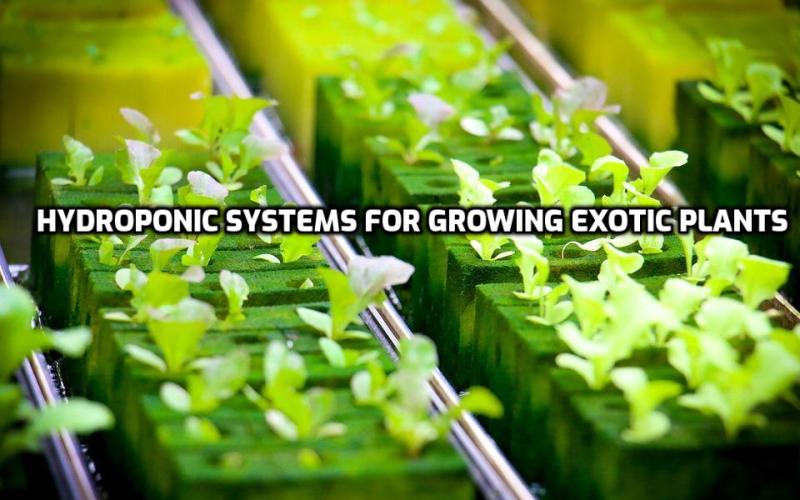Hello gardeners, we are here today with the information of Growing Exotic Hydroponic Plants for getting maxim profit. One of the frequently raised questions from beginner hydroponic gardeners are how to grow hydroponics plants “What can I grow?” The simple answer is that given the right setup and nutrient balance, you can grow any plant hydroponically only difference few flourish in the hydroponic system and few may not give desirable yields.
A step by step guide to Growing Exotic Hydroponic Plants
To select what plants would be best suited for your hydroponic system, you should think about the following factors: what type of system you have or desire to build, how much gardening space you have, how much experience or knowledge of hydroponics you have, and your reasons for diving into hydroponics.
What Kind of System Do You Have?
The two basic categories of hydroponic systems are Solution, or Liquid-based Culture and Medium, or Aggregate based Culture. In a Solution system, such as Aeroponics or Nutrient Film Technique, the plants develop directly in the nutrient-filled solution. This type of setup works great with fast-growing, shallow-rooted plants such as lettuce, spinach, radishes, and herbs.

Grow medium based systems, such as Wick Systems or Ebb & Flow systems, uses a growing medium such as Gravel, Coco-peat, or Rockwool. Because the medium provides good support for heavy plants to grow, these setups work well for vegetables and herbs with deep roots such as comfrey, chicory, and beets, or those that are heavier on top and requires support like beans, tomatoes, squash, and cucumbers.
If you don’t own a hydroponic setup yet, considering what type of plants you desire to cultivate can help out to decide what kind of system you select. If you wish to grow fresh herbs and salads, but you only have a small space to dedicate to your home garden, you may do wonders with a small D.I.Y. Wick System. If you are a somewhat experienced grower and are looking for a more exotic alternative or a way to upgrade your hydroponic garden, you may wish for get-go for a more high-technology oriented system such as Aeroponics.
You should not miss the Profitable Hydroponic Crops.
How Much Space Is Available?
Space is an important factor to think about when selecting which plants to grow in your hydroponic garden. If you only have little space to dedicate to your garden, you would do best to not grow plants like squash, melons, and other large plants which require more space to grow. In smaller systems, the simplest and most rewarding options are exotic leafy greens and hydroponic vegetables like kale, chards, broccoli, lettuce etc. These are plants that grow quickly, can be recurrently harvested, and do not require a lot of space to expand or develop fruit.
If you are lucky enough and have a large space such as a greenhouse, garage, or patio, you can opt for a more advanced system and grow those voluminous plants that require trellises and deep root support systems. Larger gardens are desirable for experimentation.
What Is Your Experience Level?
Your level of experience and understanding of the hydroponic system, gardening and your specific purpose for getting into hydroponics will also affect your choice of what plants you want to cultivate. If you are a complete beginner, it would be sensible to stick to quick-growing, easy to maintain plants so that you can obtain the maximum benefit out of your experience without becoming dispirited. Although hydroponic gardens are simple and easy to maintain once you know the basics, it is simple to get discouraged if you start out with a too complex system.
You may also like the Growing Hydroponic Ginseng.
Indoor gardening offers some wonderful opportunities when it comes to growing exotic, pricey and flavourful herbs and spices. Exotic crops such as ginger, lemongrass, lime leaf, turmeric, chillies, curry leaf, basils, chards, hydroponic artichoke, growing lavender hydroponically and even vanilla can be grown successfully while delicate and expensive saffron can be harvested from flowering corms and dried for year-round use using hydroponic system.
Best Hydroponic Systems for Growing exotic plants
Hydroponic systems for exotic herbs and spices don’t have to be complicated and falls into two major categories. For longer-term plants and those that generate rhizomes such as ginger, galangal, ginseng, turmeric, and kaffir lime, use deep media beds or shallow, free-draining media beds for saffron corms. For short duration, smaller plants such as perilla, epazote, and many other herbs and spices like dwarf chilies, utilize other soil-less systems from nutrient film technique and pond or raft system to drip, ebb, and flow or aeroponics.
Given that most of the exotic spices and herb plants that can be successfully grown hydroponically originate in tropical and subtropical climates, they are usually not particular about day length, but they do prefer heat. Most ginger species, vanilla orchids, cardamom, turmeric, curry leaf plant, lemongrass, and chilies prefer year-round warmth with an optimal temperature in the range of 72 to 86 degree Fahrenheit. Many of them can be cultivated outdoors during summers and then brought inside in overwinter as hydroponic indoor plants using portable hydroponic systems. Hope you have enjoyed reading the Growing Exotic Hydroponic Plants formaximum profits. Keep growing plants in Hydroponics!.
You may be interested in Foxtail Millet Cultivation Income, Project Report.